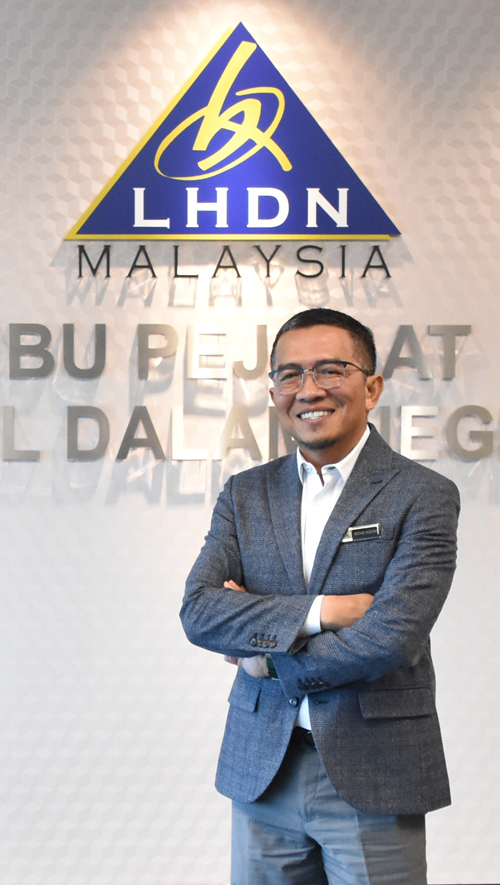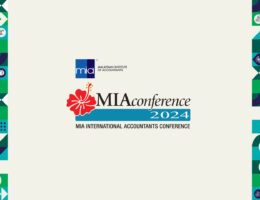By MIA Strategic Communications & Branding Team and Nazatul Izma
In any jurisdiction, trust and compliance are essential to the successful implementation of an efficient and resilient tax system.
Earlier in August 2023, the MIA Strategic Communication and Branding Team had the privilege of speaking with Dato’ Sri Dr. Mohd Nizom Sairi, Chief Executive Officer/Director General of Lembaga Hasil Dalam Negeri (LHDN) or also known as HASiL on its vision for advancing the national tax system to support nation building.

According to Dato’ Sri Dr Mohd Nizom, enhancing transparency and trust are at the core of changing taxpayer behaviours towards strengthening compliance. It is also critical to embrace digital transformation – including the upcoming e-invoicing initiative – to improve tax administration and ease compliance.
During the interview, Dato’ Sri Dr Mohd Nizom stressed the importance of enabling real time taxation processes which will make tax compliance more automatic and less onerous. “It is actually compliance by design, which means that when you are in the system, you just comply as you go along. That is the sustainable way of maintaining compliance at the highest maximum level. We cannot continue to be doing compliance traditionally in a hide and seek kind of situation, chasing and going after the non-compliant ones, which is an approach that has no end to it.”
Along with real-time taxation, HASiL is advocating for cooperative compliance to enhance tax administration and governance. This will require accountancy and taxation professionals to change their mindsets and adapt to higher-value tax advisory roles whereby they are able to better predict and mitigate tax and business risks.
Dato’ Sri Dr Mohd Nizom’s insights are derived from long experience and expertise in the national taxation ecosystem. A holder of a doctorate from the Swiss School of Management and a holder of a master’s degree from the Lawrence Technological University in the United States, he first joined LHDN on 13 November 1985. While climbing up the ranks, he amassed extensive experience in direct taxation including tax operations, tax compliance and collection, international taxation and tax training.
Throughout his career, Dato’ Sri Dr Mohd Nizom has held several important positions at LHDN including as director of the Investigation Department, Malaysian Taxation Academy, Tax Compliance Department, state director of Perak LHDN, and deputy CEO (Management). In October 2021, he was promoted to Chief Executive Officer from the position of deputy chief executive officer (Taxation Operations), replacing his predecessor Datuk Seri Dr Sabin Samitah.
Below are excerpts of the interview with Dato’ Sri Dr Mohd Nizom (answers have been edited for clarity and conciseness):
What steps can be taken to encourage nations to be more tax compliant? And what are the factors that influence what HASiL can do to incentivise or motivate tax payers and potential tax payers to be compliant?
When we talk about compliance, we are talking about behavioral management. Therefore, compliance to law and how to increase compliance to all the different laws that we have in place will basically require the same kind of initiatives or strategies. So be it tax law or any other law, I think one of the main things that we need to focus on to increase compliance is actually how the public perceives the whole system and the law itself. It is important that they have full trust that the law is good for them, and that the law is administered fairly and justly in the best manner and benefits the community as a whole. If we can increase that perception and feeling among the public, that is the best way to actually bring them to comply with the law. So, that is generally how we will approach administering the tax system in this country.
In this context, how can you enhance public trust and what steps are you taking to narrow the public trust deficit and to encourage compliance?
We have to look into how we can increase the trust of the public in the system itself from various angles. In terms of the efficiency of the system itself, justice and equity, equitable perspective of the law and the administration of the law are essential in terms of increasing transparency. When the public can feel or see (this transparency), then they will believe (in the system) and the trust will increase from there.
It is also important that we give the necessary services and advisory so that they can perform their obligation to the best of their ability and with ease, with no confusion or complication. When the awareness is increased and the understanding is there, and they are provided with the necessary assistance or services made easily available to them, this will be the beginning of the journey of increasing the trust itself.
Of course, the other side of the trust equation is how the revenue is administered. This is on the Government as a whole. We (HASil) are at the revenue generating side, whereas that relates to the expenditure. We cannot just be increasing the trust at the collecting side; trust has to encompass the whole system.
How is HASiL using technology or digital revisions to improve not just your collections, but your services, your transparency, your efficiency, and of course, public trust?
We have actually undergone a process of transforming our IT background or services. This journey took us two years, where we integrated the various systems that have been developed over the past 15 years. We began digitalising from the mid-80s throughout the early 90s which accounts for probably almost 30 years of our digital transformation journey.

Since the whole IT infrastructure was developed phase by phase, at one point we ended up with various systems to deliver or accommodate all our services. To achieve a more seamless kind of communication and integrate these different systems, we have initiated the Hasil Integrated Tax System, which provides a more real-time experience.
For example, in the past, if you made a payment today, you would only see it in the ledger at the earliest by tomorrow. This has changed now. We provide a single gateway for taxpayers to log in and see all things related to their tax matters, whether it is communication, access to services or even viewing their tax positions. This is called MyTax which is available for individuals, as well as corporate taxpayers. So, nowadays when you do your e-filing, you do not need to wait until the next day to see it in your tax position. It is more real time. This is a major transformation that has received very good feedback from the taxpayers.
In addition, more and more of the physical over the counter services, be it lodgement of returns, making payments, and more recently, even the stamp duty process have been digitalised. Everything is now on an online system, from income tax to stamp duty. This means the services are available 24/7 and anywhere, anytime, providing taxpayers with more convenience and avenues to access the services. Of course, there is a lot more room for improvement, but the basic infrastructure is there.
What other tech innovations can we expect in terms of service improvements coming up?
One of the major initiatives that we are currently embarking on now is to establish an e-invoicing environment in Malaysia. This is something that has been done in many countries, where some have had it for more than 15 years in this region, with the Philippines being the latest adopter, I think.
According to our timeline (and as announced in Budget 2024 by the Prime Minister), we are going to start e-invoicing in place as of 1 August 2024 (deferred from the original date of 1June 2024) with a certain group of companies with a turnover of more than RM100 million. The timeline will be extended until 2027 for individual taxpayers.
This initiative is part of the grand scheme of making taxation more real time earlier because this provides certainty which is of huge importance to businesses. If you want certainty, you cannot work on a historical basis, because at any point of time you are not certain. You have to wait until the time is completed and then you look backward and try to see how much your tax obligations are.
By making it more real time, at any point of time you know that you have complied with your tax obligation basically to some extent. With the help of e-invoicing, this will be made possible. Enabling real time is part of our journey of making compliance automatic. It is actually compliance by design, which means when you are in the system, you just comply as you go along. That is the sustainable way of maintaining compliance at the highest maximum level. We cannot continue to be doing compliance traditionally in a hide and seek kind of situation, chasing and going after the non-compliant ones, which is an approach that has no end. Designing compliance into the system is a sustainable way of going forward.
If we are talking about designing compliance systems, what about those outside in the shadow economy?
The digitalisation of the economy nowadays has made it a lot easier to bring those in the shadow economy into the net. For example, all sectors will be involved with e-invoicing. You can no longer be doing business in the country if you are not in the system, with the exception of illegal activities which are done under the radar. This is definitely going to reduce the shadow economy’s size, and hopefully, it will be reduced to just the illegal activities. So, all legal activities will be captured within the net.
Handling the illegal activity is a different story altogether, but this is made possible by technology nowadays. In the old days, you do business manually and you make payment more on a cash basis, and this is a part of the shadow economy. If everything is electronic, and especially when there is an increase of e-payment mechanisms, everything will be captured within the system and we can reduce such activities.
Also, when we have designed compliance into the system, part of the resources are to maintain the system while the other part of our resources can be used to look for those who are outside of this net, to bring them in. We already know that they are in the net because they are somewhat compliant already, so we just have to manage the infrastructure.
Speaking of infrastructure, do you use technologies like blockchain and data analytics to capture more of these people?
I think this is something that is inevitable. Artificial intelligence, using robotics in the process, are tools that we cannot do without as more businesses are online based on a digital platform nowadays. Many businesses are not seen physically, especially in the services industry. Even in the retail business, you don’t see shops. Sometimes there are businesses that actually do retail but don’t hold any stocks. They just manage in terms of being a supplier or producer to the consumer. If we do not keep up with these developments, definitely we will be missing a lot in terms of ensuring that these businesses are inside the net.

How do you ensure that your people are on board with all these innovations? How are you changing your culture?
In terms of training talents in the necessary fields, we are no longer just looking at tax law and the accounting perspective, but more and more at technology. We are creating more people who are good in the business process, and also at the same time adept in the technology process, because they have to be merged to support each other. In fact, in the IT industry now, what used to be support services should be the driver of the organisation. Otherwise, you will be slacking behind.
How do you think MIA can collaborate with LHDN to further improve education and professional development for tax professionals?
With regards to the accountancy profession and tax, the journey is actually towards compliance by design, to increase more cooperative compliance.
Therefore, the accountancy profession’s role as the intermediary between the taxpaying community and the tax authority has to shift. Initially, accountants began as preparers, tax preparers, tax mitigators when there are disputes, but that was when tax was historical in nature, and you compute your tax for last year.
As we shift to more real time situations, the profession has to increase cooperative compliance activities. In future, the role of the profession should be looking at how to mitigate and how to avoid risk. What are the potential risks in terms of tax? How do you provide the right advisory in terms of how best businesses should be handling their tax matters? You have to make the shift from historical to current and future. That takes a lot of upskilling because historically the skills are more on computation.
Going forward, there needs to be more planning. The profession has to understand business more than in the past. Accountancy professionals have to move from just looking at figures and trying to compute the tax obligation, to understanding the business and identifying potential risks. This should be the direction that will be in line with the tax authorities’ intention of managing behavior to enhance compliance. We are not focused on just the revenue but looking at how can we steer them to the right direction.





